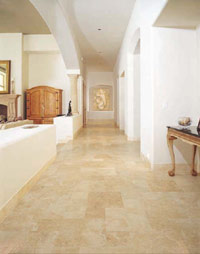A mixture of clays that are pressed into shape and fired at high
temperatures which gives the tile it’s hardness. The bisque, or body, of ceramic
tile may then be glazed, or left unglazed depending on it’s intended
use.
Classifications of Ceramic Tile — P.E.I. Wear Ratings
Group I: Tiles that are suitable for residential bathrooms with light foot
traffic. Generally wall tile products fall into this group. Some wall tiles
can be used on the floor. Consult the manufacturer of the tile for their
recommended areas of application.
Group II: Tiles that can be used in residential traffic areas, expect
areas with high traffic, such as in kitchens, foyers, laundry rooms, etc.
Group III: Products that are recommended for all residential installations.
Group IV: Tiles that are suited for all residential and light to medium
commercial.
Group V: These tiles can be in heavy traffic areas and are recommended
for wet areas where safety is a concern, such as in food service areas,
exterior areas, shopping malls and swimming pools etc.
Types of Ceramic Tile
Glazed – The most common style today in floor and wall tiles, as well
as for residential and commercial applications. A liquid glass is applied
to the body of the tile and fired at high temperatures. The glazing becomes
hard and non-porous resulting in a flooring that is:
- Stain Resistant
- Scratch Resistant
- Fire Resistant
- Doesn’t Fade from Sun Light
- Slip Resistant
- Easy to Clean
Shiny glazes are softer, can be scratched easier, and can be slippery
than the satin or rustic finishes.
Unglazed – There
is no glazing or any other coating applied to the tile. Their color is
the same on the face of the tile as it is on
the back resulting in very durable tiles that do not show the effects
of heavy traffic. The most common unglazed tiles are the red quarry tiles
or the granite looking porcelain ceramic tiles used in heavy commercial
areas.
Tile Density and Moisture Absorption
Tile Density – As the weight or the density increase
it becomes a stronger tile.
Moisture Absorption – As the density increases the amount of moisture
that a tile can absorb becomes less.
Tile density and moisture absorption have an indirect relationship to
each other. As the density of the tile increases the moisture absorption
rate becomes less. Tile density and moisture absorption are important
to understand when selecting the tiles for different applications.
Non-Vitreous Tiles – tiles that absorb 7% or more moisture. Suited
for indoor use only.
Semi-Vitreous Tiles – tiles that absorb from 3% to 7% moisture.
Suited for indoor use only.
Vitreous Tiles – tiles that absorb less that 3% moisture. Referred
to as frost resistant tiles but can not be used in exterior areas where
freeze thaw conditions could cause tile cracking.
Impervious Tiles – tiles that have less than .5% moisture absorption.
These tiles are frost proof and can be used in exterior areas or on the
outside of building facades.
Production Methods
Monocottura – It is an Italian word meaning, "single fired".
The tile passes through the firing process one time at a temperature of
2200 degrees. Monocuttura tiles have denser bodies and harder glazes than
Bicottura tiles.
Bicottura - It is an Italian word meaning "double fired". The
clay body is fired on the first pass through the kiln, and the glaze is
applied and fired on the second pass through the kiln. This process is
only being used today for decorative wall tile products.
White Body Tile versus Red Body Tile
The color of the body is determined by the color of the clay used by the
manufacturer that is available in their geographic region. Look at the body
of the tile to see if the color is red or white. The quality of the tile
is more related to the quality of the manufacturer not the color of the
body.
Wall Tile Trims
Bullnose – This is the most used trim shape for wall tile installations.
Wall tile bullnose is sometimes referred to as
surface cap. It has one rounded
finished edge on the tile and can be used horizontally or vertically.
Corner Bullnose – It has two rounded finished edges on the tile
to be used to complete the corner where the horizontal and vertical bullnose
meet. Generally you use only 2 – 3 pieces for a bathtub enclosure.
Stack-on Cove Base – This cove base provides a coving on the bottom
and a flat edge on top to continue with more wall tile up the wall.
Rounded Top Cove Base – This cove base has a rounded finished top
like bullnose and is used as a cove base in areas that will not have wall
tile installed above it.
The above trims are the most commonly used. There are many other specialty
trims available. Our tile estimator will be able to look at your installation
and know what trims will be needed.
Floor Tile Trims
Some manufacturers do not provide trim pieces for their products. There are
many other ways to finish off the job; Corian, Marble, Granite, Wood, Metal
and plastic trim accessories.
Bullnose – It has one rounded finished edge on the tile to give
a nice finishing touch. Sometimes it is also used as a substitute for cove
base.
Sanitary Cove Base – It has a rounded finished top like a bullnose
to cover up the body of the tile.
Natural stone, although it can be ordered in slab form, usually
is cut into tiles from quarried blocks of granite, marble, limestone, slate
or other rock. Although floors made from this material are expensive

and
hard on the feet, they provide an exceptionally beautiful flooring material
that
has a timeless, elegant quality.
All of these materials are extremely durable and offer a natural look.
There is definitely a reason they are referred to as "hard surface." These
floors offer no resiliency, are cold underfoot and noisy in comparison to
other types of floors. Some types absorb stains easily and the stains are
difficult to remove. They are extremely low maintenance and hard wearing.
These stone materials do require a strong subfloor below.
Polished stone can be slippery when wet. Options to this include Honed
stone, which has been ground flat but not polished, or textured tiles created
by sandblasting or heating with a torch. Stone tiles are usually at least
a foot square, but may also be available in mosaic style pieces either for
borders, or arranged into designs that can be installed just like regular
sized tiles.
Limestone and marble are popular choices but another big seller is travertine
because of its versatility.
Travertine is a limestone that is resistant to traffic, is a naturally
neutral color and can give either a casual or elegant look. It is also a
stone that is resistant to staining and wear. People often like to combine
travertine and a tumbled finish to create an antique look.
